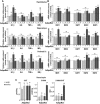Adiporon, an adiponectin receptor agonist acts as an antidepressant and metabolic regulator in a mouse model of depression
- PMID: 30115912
- PMCID: PMC6095913
- DOI: 10.1038/s41398-018-0210-y
Adiporon, an adiponectin receptor agonist acts as an antidepressant and metabolic regulator in a mouse model of depression
Abstract
Major depression is a psychiatric disorder with complex etiology. About 30% of depressive patients are resistant to antidepressants that are currently available, likely because they only target the monoaminergic systems. Thus, identification of novel antidepressants with a larger action spectrum is urgently required. Epidemiological data indicate high comorbidity between metabolic and psychiatric disorders, particularly obesity and depression. We used a well-characterized anxiety/depressive-like mouse model consisting of continuous input of corticosterone for seven consecutive weeks. A panel of reliable behavioral tests were conducted to assessing numerous facets of the depression-like state, including anxiety, resignation, reduced motivation, loss of pleasure, and social withdrawal. Furthermore, metabolic features including weight, adiposity, and plasma biological parameters (lipids, adipokines, and cytokines) were investigated in corticosterone-treated mice. Our data show that chronic administration of corticosterone induced the parallel onset of metabolic and behavioral dysfunctions in mice. AdipoRon, a potent adiponectin receptor agonist, prevented the corticosterone-induced early onset of moderate obesity and metabolic syndromes. Moreover, in all the behavioral tests, daily treatment with AdipoRon successfully reversed the corticosterone-induced depression-like state in mice. AdipoRon exerted its pleiotropic actions on various systems including hippocampal neurogenesis, serotonergic neurotransmission, neuroinflammation, and the tryptophan metabolic pathway, which can explain its antidepressant properties. Our study highlights the pivotal role of the adiponergic system in the development of both metabolic and psychiatric disorders. AdipoRon may constitute a promising novel antidepressant.
Conflict of interest statement
S.N., A.G., and J.C. are co-inventors of a patent entitled “Use of adiponectin receptor agonists in treating depression, anxiety and neuroinflammation” (registration ref # 17 305953.6). The other authors declare that they have no conflict of interest.
Figures




Similar articles
-
Increasing Adiponergic System Activity as a Potential Treatment for Depressive Disorders.Mol Neurobiol. 2019 Dec;56(12):7966-7976. doi: 10.1007/s12035-019-01644-3. Epub 2019 May 28. Mol Neurobiol. 2019. PMID: 31140056 Free PMC article. Review.
-
The adiponectin receptor agonist AdipoRon normalizes glucose metabolism and prevents obesity but not growth retardation induced by glucocorticoids in young mice.Metabolism. 2020 Feb;103:154027. doi: 10.1016/j.metabol.2019.154027. Epub 2019 Nov 26. Metabolism. 2020. PMID: 31778708
-
Liraglutide attenuates the depressive- and anxiety-like behaviour in the corticosterone induced depression model via improving hippocampal neural plasticity.Brain Res. 2018 Sep 1;1694:55-62. doi: 10.1016/j.brainres.2018.04.031. Epub 2018 Apr 27. Brain Res. 2018. PMID: 29705602
-
Depression- and anxiogenic-like behaviors induced by lipopolysaccharide in mice are reversed by a selenium-containing indolyl compound: Behavioral, neurochemical and computational insights involving the serotonergic system.J Psychiatr Res. 2019 Aug;115:1-12. doi: 10.1016/j.jpsychires.2019.05.006. Epub 2019 May 4. J Psychiatr Res. 2019. PMID: 31082651
-
AdipoRon: A Novel Insulin Sensitizer in Various Complications and the Underlying Mechanisms: A Review.Curr Mol Pharmacol. 2020;13(2):94-107. doi: 10.2174/1874467212666191022102800. Curr Mol Pharmacol. 2020. PMID: 31642417 Review.
Cited by
-
Increasing Adiponergic System Activity as a Potential Treatment for Depressive Disorders.Mol Neurobiol. 2019 Dec;56(12):7966-7976. doi: 10.1007/s12035-019-01644-3. Epub 2019 May 28. Mol Neurobiol. 2019. PMID: 31140056 Free PMC article. Review.
-
Exploring the New Horizon of AdipoQ in Obesity-Related Alzheimer's Dementia.Front Physiol. 2021 Jan 27;11:567678. doi: 10.3389/fphys.2020.567678. eCollection 2020. Front Physiol. 2021. PMID: 33584324 Free PMC article. Review.
-
Increasing Adiponectin Signaling by Sub-Chronic AdipoRon Treatment Elicits Antidepressant- and Anxiolytic-Like Effects Independent of Changes in Hippocampal Plasticity.Biomedicines. 2023 Jan 18;11(2):249. doi: 10.3390/biomedicines11020249. Biomedicines. 2023. PMID: 36830788 Free PMC article.
-
Anti-depressive-like behaviors of APN KO mice involve Trkb/BDNF signaling related neuroinflammatory changes.Mol Psychiatry. 2022 Feb;27(2):1047-1058. doi: 10.1038/s41380-021-01327-3. Epub 2021 Oct 12. Mol Psychiatry. 2022. PMID: 34642455
-
AdipoRon Affects Cell Cycle Progression and Inhibits Proliferation in Human Osteosarcoma Cells.J Oncol. 2020 Jan 22;2020:7262479. doi: 10.1155/2020/7262479. eCollection 2020. J Oncol. 2020. PMID: 32411241 Free PMC article.
References
Publication types
MeSH terms
Substances
LinkOut - more resources
Full Text Sources
Other Literature Sources
Medical

